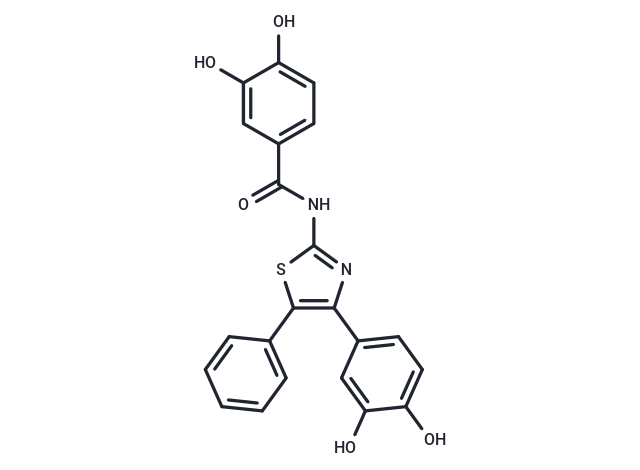 您的购物车当前为空
您的购物车当前为空
COH29
一键复制产品信息货号 T3157Cas号 1190932-38-7
别名 RNR Inhibitor COH29
COH29 (RNR Inhibitor COH29) 是一种口服可用的芳香族取代噻唑,是人类核糖核苷酸还原酶 (RNR) 的抑制剂,具有潜在的抗肿瘤活性。它抑制核糖核苷酸还原酶的IC50为 16 μM。


为众多的药物研发团队赋能,
让新药发现更简单!
COH29
一键复制产品信息货号 T3157 别名 RNR Inhibitor COH29Cas号 1190932-38-7
COH29 (RNR Inhibitor COH29) 是一种口服可用的芳香族取代噻唑,是人类核糖核苷酸还原酶 (RNR) 的抑制剂,具有潜在的抗肿瘤活性。它抑制核糖核苷酸还原酶的IC50为 16 μM。
| 规格 | 价格 | 库存 | 数量 |
|---|---|---|---|
| 1 mg | ¥ 768 | 现货 | |
| 2 mg | ¥ 1,130 | 现货 | |
| 5 mg | ¥ 1,880 | 现货 | |
| 10 mg | ¥ 2,820 | 现货 | |
| 25 mg | ¥ 3,790 | 现货 | |
| 50 mg | ¥ 5,430 | 现货 | |
| 100 mg | ¥ 7,390 | 现货 | |
| 200 mg | ¥ 9,990 | 现货 | |
| 1 mL x 10 mM (in DMSO) | ¥ 1,980 | 现货 |
大包装 & 定制
加入购物车
TargetMol 的所有产品仅用作科学研究或药证申报,不能被用于人体,我们不向个人提供产品和服务。请您遵守承诺用途,不得违反法律法规规定用于任何其他用途。
COH29 相关产品
更多
产品介绍
生物活性
化学信息
| 产品描述 | COH29 (RNR Inhibitor COH29) is an orally available, aromatically substituted thiazole and inhibitor of the human ribonucleotide reductase (RNR), with potential antineoplastic activity. Upon oral administration, the RNR inhibitor COH29 binds to the ligand-binding pocket of the RNR M2 subunit (hRRM2) near the C-terminal tail. Inhibition of RNR activity decreases the pool of deoxyribonucleotide triphosphates available for DNA synthesis. The resulting decrease in DNA synthesis causes cell cycle arrest and growth inhibition. In addition, this agent may inhibit the nuclear enzyme poly (ADP-ribose) polymerase (PARP) 1, which prevents the repair of damaged DNA and causes both the accumulation of single and double strand DNA breaks and the induction of apoptosis. |
| 靶点活性 | RNR:16 μM. |
| 体外活性 | COH29成功克服了Y细胞对吉西他滨和羟基脲的抗药性。在NCI 60人类Y系列的大多数细胞系中,它强效抑制增殖,但对正常成纤维细胞或内皮细胞几乎无影响。NMR、定点突变技术和表面等离子体共振生物传感器研究确认COH29与提议的配体结合口袋结合,并为RRM1-RRM2四聚体结构的组装阻断提供了证据[1]。 |
| 体内活性 | COH29 (50/100 mg/kg, b.i.d., p.o.)在MOLT-4肿瘤移植模型中显示出剂量依赖性的抑制增长效果,尤其在治疗第12天时抑制效果显著。在携带TOV11D肿瘤移植物的小鼠中,连续7天使用COH29 (200/300/400 mg/kg/天)同样展示出剂量依赖性的肿瘤生长抑制效果。与对照组相比,肿瘤增长被显著抑制[1]。 |
| 激酶实验 | For kinase assays following immunoprecipitation of FLAG-CDK7 protein from HCT116 or FLAG-CDK12 from 293A cellular lysates, cells are first treated with THZ1, THZ1-R, or DMSO for 4 hrs at 37°C. Cells are then harvested by lysis in 50 mM Tris HCl pH 8.0, 150 mM NaCl, 1% NP-40, 5 mM EDTA, and protease/phosphatase cocktails. Exogenous CDK7 or CDK12 proteins are immunoprecipitated from cellular lysates using FLAG antibody- conjugated agarose beads. Precipitated proteins are washed with lysis buffer 6 times, followed by 2 washes with kinase buffer (40 mM Hepes pH 7.5, 150 mM NaCl, 10 mM MgCl2, 5% glycerol) and subjected to in vitro kinase assays at 30°C for 45 minutes using 1 μg of the large subunit of RNAPII (RPB1) as substrate and 25 μM ATP and 10 μCi of 32P ATP. Kinase assays using recombinant CDK7/TFIIH/MAT1 are conducted in the manner as described above using 25 ng of CAK complex per reaction. For kinase assays designed to test time-dependent inactivation of CDK7 kinase activity, CAK complex is pre-incubated with indicated concentrations of THZ1, THZ1-R, or DMSO in kinase buffer without ATP for 4 hrs at 30°C prior to being subjected to kinase assay conditions[1]. |
| 细胞实验 | Cells is seeded into 96-well plates in 100 μL of complete medium at 2000 to 5000 cells per well, depending on the cell line's growth rate. After overnight incubation, test compound is added to each well at various concentrations in 50 μL of culture medium. After a further incubation for 96 hours at 37°C, fluorescein diacetate (final concentration: 10 mg/mL) and eosin Y [final concentration: 0.1% (w/v)] is added to each well, and the cells is incubated for an additional 20 minutes at 37°C. Cytotoxicity is assessed by Digital Imaging Microscopy System detection Viability is assessed using MTS [(3-(4,5-dimethylthiazol-2-yl)-5-(3-carboxymethoxyphenyl)-2-(4-sulfophenyl)-2H-tetrazolium)] as previously described[1]. |
| 别名 | RNR Inhibitor COH29 |
| 分子量 | 420.44 |
| 分子式 | C22H16N2O5S |
| CAS No. | 1190932-38-7 |
| Smiles | Oc1ccc(cc1O)C(=O)Nc1nc(c(s1)-c1ccccc1)-c1ccc(O)c(O)c1 |
| 密度 | no data available |
储存&溶解度
| 存储 | Powder: -20°C for 3 years | In solvent: -80°C for 1 year | Shipping with blue ice/Shipping at ambient temperature. | |||||||||||||||||||||||||||||||||||
| 溶解度信息 | DMSO: 50 mg/mL (118.92 mM), Sonication is recommended. | |||||||||||||||||||||||||||||||||||
| 体内实验配方 | 10% DMSO+40% PEG300+5% Tween 80+45% Saline: 2 mg/mL (4.76 mM), Sonication is recommended. 请按顺序添加溶剂,在添加下一种溶剂之前,尽可能使溶液澄清。如有必要,可通过加热、超声、涡旋处理进行溶解。工作液建议现配现用。以上配方仅供参考,体内配方并不是绝对的,请根据不同情况进行调整。 | |||||||||||||||||||||||||||||||||||
溶液配制表 | ||||||||||||||||||||||||||||||||||||
DMSO
| ||||||||||||||||||||||||||||||||||||
计算器
体内实验配液计算器
请在以下方框中输入您的动物实验信息后点击计算,可以得到母液配置方法和体内配方的制备方法:
剂量转换
对于不同动物的给药剂量换算,您也可以参考 更多
引用文献
关键词
评论列表
Related Tags: buy COH29 | purchase COH29 | COH29 cost | order COH29 | COH29 chemical structure | COH29 in vivo | COH29 in vitro | COH29 formula | COH29 molecular weight




 很棒
很棒

 |
|
评论内容